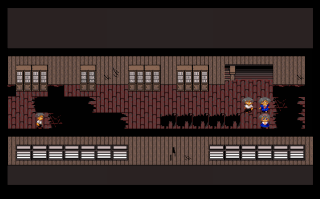Note: Corpse Party’s official Japanese products and spinoffs like to use real English in their titles, and they have made all kind of creative spelling and punctuation decisions over the years. All caps, all lowercase, camel-case; with colons between title and subtitle, without colons, double colons, semicolons in place of colons… For simplicity’s sake, I’ve spelled and punctuated them as an English publisher would have titled them. The only exceptions to this rule are titles related to the original PC-98 game, which English fans have standardized as “CORPSE-PARTY.”
The real-world history of Corpse Party is one for the books. The original title, CORPSE-PARTY, was the brainchild of Makoto “Kedwin” Kedouin, working under the name “Kenix Soft”. Kedouin submitted the game to a 1996 contest for RPG Maker games using the original RPG Maker program, RPG Maker Dante 98 for the PC-98. CORPSE-PARTY won second prize, was publically released via magazine, and was later made available for free online. The game became a cult classic, and was rebooted in the late 2000s as Corpse Party: Blood Covered, which became the start of a second series. Blood Covered was followed by Corpse Party: Book of Shadows, then Japanese-only comedy spinoff “Corpse Party -THE ANTHOLOGY- Sachiko’s Game of Love ♥ Hysteric Birthday 2U”, and then the finale, Corpse Party: Blood Drive. This series proved even more popular than the original, and has seen adaptations into manga, light novels and even live-action films. The developers have also started work on Corpse Party 2: Dead Patient, an episodic game that is only partially complete.
The original CORPSE-PARTY set an unusual precedent. While built on an RPG framework, it gutted most of the combat and focused the game on puzzles, essentially making it an Adventure game played in an RPG engine. The original game inspired numerous fan projects, and with the help of Yume Nikki in 2004, these “RPG-Adventure” games have become something of a minor genre today, popular on the hobbyist and indie scene. The genre is sometimes called “RPG Horror games”, though this is misleading both in terms of development tool and narrative genre. True, many notable entries in the genre are horror games, like Ib, Ao Oni, and The Crooked Man series, but the genre also includes modern classics like To the Moon.
It is worth noting that Corpse Party features several mysteries that go on to become fundamental parts of later entries in the series. As a consequence, this article will have to spoil some of the bigger reveals.
The story of the original CORPSE-PARTY is quite simple, given that it had to be developed in time for a contest: a group of high school students, plus the younger sister of the central protagonist, have gathered in school after class and are arbitrarily transported into an alternate dimension made up of a haunted elementary school. They will have to find a way out, while ghosts and other supernatural hazards try to end them in colorful ways. They will eventually discover the school’s secret, a deeply unpleasant tale of rape and murder, but whether they all get out alive is up in the air.
Characters
Satoshi Mochida
The first game’s protagonist-by-default. A nominal coward, Satoshi is also a natural leader, and the latter tends to blot out the former, leaving him something of a bore. Hysteric Birthday has a few laughs at how generic he is, and also how everyone seems to be in love with him for no reason, but he’s a workable protagonist all the same.
Naomi Nakashima
The series’ poster girl, Naomi has a good head on her shoulders, which only goes so far against the supernatural. The games seem to like to torture her special, although the form this takes varies from entry to entry. That she’s pulled through so much awfulness and is still standing is something to be admired.
Yuka Mochida
Satoshi’s middle-school-aged sister, who for some reason behaves even younger. Yuka seems to be utterly reliant on her older brother, so it should come as no surprise that the games like to split them up as soon as possible, so that they suffer. Yuka has a secret to tell her big brother that this whole ghost dimension thing seems to have gotten in the way of.
Ayumi Shinozaki
The class president, or representative to the student council, depending on the translation. Ayumi is an occult-obsessed fan of horror stories that loves to scare her classmates. She can’t take the real thing at first, and seems especially vulnerable to black magic, but gradually comes into her own and ultimately becomes the lead of Blood Drive.
Yoshiki Kishinuma
In the original game, Yoshiki is the class delinquent, though in the second series, he’s in the middle of moving away from all that. Has an unrequited crush on Ayumi, and insists on teaming up with her whenever possible.
Sachiko Shinozaki
Simply “The Girl in Red” for most of the original game, Sachiko picked up her given name in the reboot and uses it almost exclusively. Sachiko is clearly responsible for the party’s misery in the original, but her role is initially a mystery in the remake. Anyone familiar with the original is unlikely to be fooled. The remake version is pictured here since she doesn’t have a portrait in the original PC-98 game.
In terms of gameplay, CORPSE-PARTY works just like you’d expect from an RPG with no combat. You solve puzzles by examining objects, flipping switches, or picking up items and using them elsewhere. If you examine a puzzle and are carrying the item required to solve it, the game will give you the option to do. It’s generally quite easy, but there are a few movement puzzles and timers to contend as well.
CORPSE-PARTY seems take some of its inspiration from Capcom’s founding horror RPG game, Sweet Home. This is more unusual than it might sound, as CORPSE-PARTY was developed and submitted to its contest prior to the release of Resident Evil / Biohazard, the game that reinvigorated interest in Sweet Home. Like Sweet Home, you have a party of five: two male, three female, one of which is a young girl. You have the ability to switch between multiple parties, one of three members and one of two. Like in Sweet Home, characters that die will die for good, forcing you to carry on without them, although death is less frequent in CORPSE-PARTY, where you don’t have random encounters. Unlike in Sweet Home, CORPSE-PARTY‘s two parties are pre-formed, confined to respective halves of the schools, and you switch via pentagrams on the map rather than via the menu. CORPSE-PARTY also lacks character-specific items, as the fact that characters are in set areas eliminates the need for any.
One thing hampering the original CORPSE-PARTY‘s horror vibes is the RPG detritus cluttering up the interface. Characters still have stats that greet you every time you open the menu, and magic and party reorganization submenus sit on the main menu, virtually useless. Since the game saves via the main menu, you run into these things every few minutes. In Kedouin’s defence, perhaps these features couldn’t be removed in the early version of RPG Maker (they’re not alone: a fantasy splash screen appears for a split second when you boot up the game!), and even if they could, the time constraints of the contest probably made them less important.
As it happens, the RPG elements aren’t completely irrelevant. While CORPSE-PARTY has removed most of the game’s RPG combat, there is a single battle in the game against a “final boss”, which feels baffling and out-of-place. Every character plays a specific RPG role in the battle, and the player is asked to select a party of three out of the survivors after only a brief summary of their abilities. Most of the difficulty comes from your lack of familiarity than anything else!
The contest’s harsh harsh time limit didn’t help with the aesthetics, either. While every graphic in the game is new, they’re heavily repeated, and there are very few puzzles. The visual horrors of the school never quite stop feeling like RPG decorations, even though all the game’s graphics are brand new. A puddle of bile is one thing, but three hundred identical puddles, lining the halls, is almost mundane! In the end, CORPSE-PARTY just can’t muster the atmosphere to equal its genre-founding gameplay, descent music, and narrative, but time and remakes would pick up the slack.
CORPSE-PARTY has multiple endings, divided by grade, with the one “A”-rank ending for getting through the game with all survivors, several “B”-rank endings for losing one party member, and numerous “D”-rank endings for losing more. There are unique endings for every possible combination of deaths. The single “C”-rank ending is a curiosity, as it plays out identically to Ending B-3 despite a change in circumstances. These two identical endings are thought to be an oversight.
The biggest issue with CORPSE-PARTY‘s multiple endings is that there are only a few opportunities to actually lose party members (dying in the final battle doesn’t count), so earning a new ending requires you to replay a huge chunk of the game, even with careful saving. While the game is hardly a full-sized RPG, that’s still asking a lot. While the series (largely) did away with this in the remake, many RPG-Adventures appear to have never learned, and this remains a genre nuisance to this day.
As a PC-98 game, CORPSE-PARTY is something of an antique and is hard to get running today, and no version of the PC-98 game exists in English. For anyone willing to try, RPG Maker Dante emulators exist, which spares the trouble of emulating the entire PC-98.
Better yet, an anonymous Japanese fan ported the game to Windows using RPG Maker XP in early 2011 as CORPSE-PARTY -Rebuilded-. This version saw multiple translations, including into English as CORPSE-PARTY -Rebuilt-. The translation was completed by fan translation group Memories of Fear in 2012. -Rebuilt- features largely the same content as the original, including the original music, but with new (but still charmingly amateurish) graphics, as well as a modified Ending C that acknowledges the change in circumstances seemingly overlooked by the original. As the newer version of RPG Maker added a run button, -Rebuilt- makes use of it and slows down the default walk speed to compensate. It may have gone too far: the player’s movement speed is now so slow that the new run speed is still slower than the PC-98.
CORPSE-PARTY -Rebuilt- also makes some dubious changes to an enemy encountered part-way through the game. This monster – a living, anatomical model found in the school’s science lab – is an early example of an RPG-Adventure enemy staple, which fans call “chasers”. Chasers pursue the player and causes damage or death on contact. In the PC-98 release, the anatomical model moves partially at random, and is slow compared to the player character. The player must solve a puzzle to escape it. The remake changes things so the model travels straight towards the player, and at lightning speed. The puzzle is the same, but it’s gone from being nearly harmless to the single most dangerous encounter in the game!
After the success of the original, Kedouin began development of a CORPSE-PARTY 2, tentatively titled Satsuki’s Heart, after its new protagonist. Unfortunately, Satsuki’s Heart never got beyond demo stage, and said demo was never publically released, although some of its assets ended up online over the years thanks to sources unknown. Fans have noted that development of CORPSE-PARTY 2 seems to have ceased around the release of RPG Maker Dante 98 II, although no official statement was ever made on the matter. With Satsuki’s Heart cancelled, Corpse Party wouldn’t see another game until the late 2000s. In the interim, the game saw a number of imitators, as well as several fan-sequels. One of these fan-sequels was CORPSE-PARTY ZERO, which proved popular enough to warrant cameos in later official games. Memories of Fear has translated several of these CORPSE-PARTY fan sequels and descendants (including ZERO), also available on their site.
Links:



